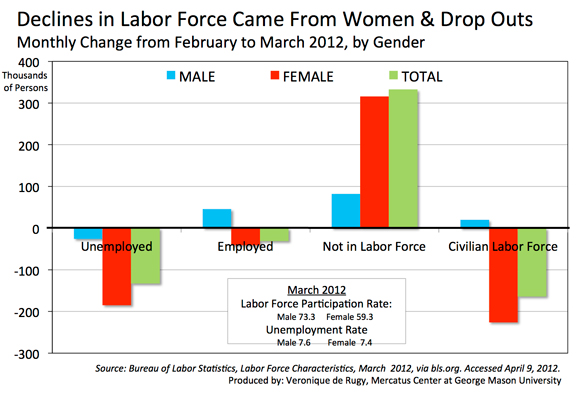- | Government Spending Government Spending
- | Data Visualizations Data Visualizations
- |
Declines in Labor Force Came From Women and Drop Outs
The BLS reported the official measure of unemployment for March 2012 at 8.2 percent, slightly lower than the previous month. Rather than actual job creation, the seemingly unchanged unemployment rate is actually anchored by ailing prospects for women and those who have stopped searching.

In this week's chart, Mercatus senior research fellow Veronique de Rugy uses data from the Bureau of Labor Statistics (BLS) to show the monthly change in labor force characteristics by gender from February to March 2012.
The BLS reported the official measure of unemployment for March 2012 at 8.2 percent, slightly lower than the previous month. Rather than actual job creation, the seemingly unchanged unemployment rate is actually anchored by ailing prospects for women and those who have stopped searching.
The overall civilian labor force declined by 164,000. This decline in labor force participation all came from women: male participation grew by 20,000, while female participation fell by 226,000 (fourth category).
Also the data show that the number of unemployed for each gender fell (first category). However the number of employed and “not in labor force” (neither working nor looking for work) grew disproportionately: employed men grew by 46,000, while employed women declined by 41,000 (second category). Lastly, the number of females not in labor force or dropouts grew four times the amount of males who were not in labor force.
When people drop out of the labor force, the unemployment rate is artificially low. If you are not in the labor force, you are not counted as unemployed.
Veronique de Rugy provides a comparison of the unemployment rate from several perspectives with Jason Fichtner in a Mercatus Chart.

